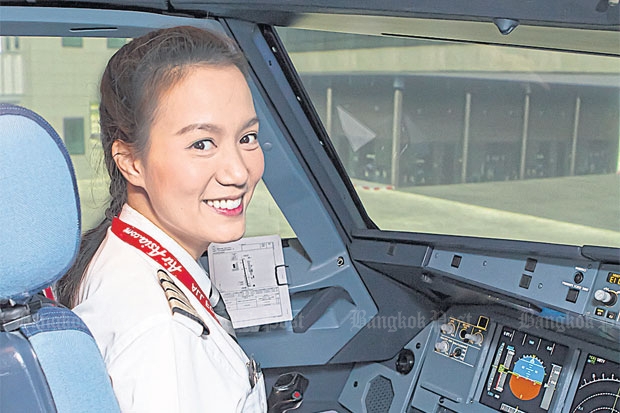
More and more women across Asia are sitting in the cockpits of commercial airliners as cultural barriers preventing them from becoming aviators are slowly dismantled.
Several Asian countries are boosting the numbers of female pilots to take on the widely perceived male-dominated airline industry.
In India, for instance, nearly 12% of all pilots are women, with almost 15% of all new pilot licenses going to women.
In Thailand, 67 women are flying commercial airliners at the rank of fully fledged captain or first officer, up from the handful seen 10 years ago, according to figures compiled by the Bangkok Post.
But female pilots remain a relatively rare breed in the skies, making up a mere 3% of commercial pilots worldwide -- 4,000 compared with 130,000 men.
The global figures are not far off from those in Thailand, where just 2% of all commercial airline pilots, who number more than 3,350, are women.
The perception of piloting as a male job remains at the heart of the female aviator shortage, Christopher Magdangal, general manager of Philippine flight academy Alpha Aviation Group, pointed out.
"It's in the cabin, not the cockpit, that women traditionally see themselves," he told the Bangkok Post, explaining why 80% of cabin crew around the world are women.
"It is therefore more the culture and perceptions surrounding women in the cockpit than the actual job practicalities that are keeping women at bay."
Such trend is seen at Alpha Aviation, with 20% of the group’s recent pilot training intake being women, according to Mr Magdangal.
He advocated airlines providing subsidised training for women aspiring to be flying, rather than setting a quota system and overcoming issues surrounding long hours, financial security and being away from family for extended periods of time -- the causes failing women to embrace the cockpit.
He concluded by saying that the culture of the pilot industry that thoroughly needs reforming, away from being perceived as a ‘male’ industry, as are many other technical, math or science-based careers.
"The reality is that piloting really can be for anyone,'' he said, citing many of the women who have trained with Alpha Aviation come from a range of backgrounds – including a former national swimming champion, a race car driver and a Red Cross volunteer.
In Thailand, gender discrimination is not an issue for most airlines when recruiting pilots.
"We look at their professional capabilities rather than gender, and no one says we cannot get them," said Capt Yuthakarn Purintrapibal, manager for training and standards at Thai AirAsia, which has the largest number of female pilots with 25.
In the US from 2000-10, the number of female pilots rose by nearly 19%.
In Britain, low-cost carrier EasyJet has launched an initiative to double the number of female entrants to piloting over the next two years.
British Airways has also publicly stated its desire to raise awareness of piloting as a career for women.
In Thailand, airlines that previously did not employ female pilots, notably Thai Lion Air and Nok Air, have reversed themselves.
There are 11 female pilots flying for Thai Lion Air and seven at Nok Air, while flag carrier Thai Airways International continues to shun their entry.
Airline initiatives to recruit female pilots may be due partly to an increasing need for pilots in general.
US plane maker Boeing recently said by 2034, a total of 558,000 new pilots would be needed including 226,000 in Asia-Pacific.